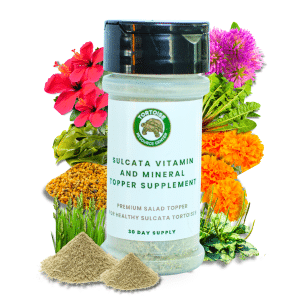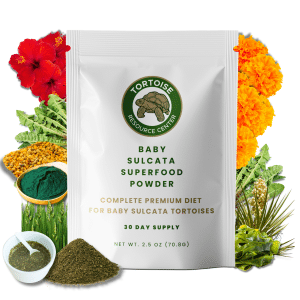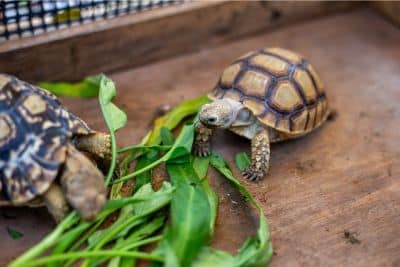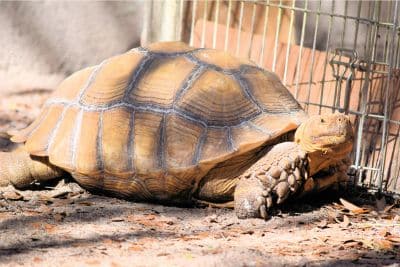For the most part, tortoises are undemanding pets. They don’t require daily walks like a dog does or need their keeper to monitor complicated water chemistry values like many fish do.
But that doesn’t mean you can just bring home a tortoise, toss him in a tank, and expect him to thrive. You’ll need an enclosure or tortoise tank set-up that functionally replicates his natural habitat.
Fortunately, that’s not particularly difficult to do – you just need to obtain the right kind of equipment and set up the tank in the proper manner. In this article I’ll outline everything you need to know, so that you will have the best chance of giving your pet a long, healthy, and happy life.
Everything You Need for the Ideal Tortoise Tank Setup
Before you can start setting up your tortoise’s tank, you’ll have to gather all of the equipment you need. We’ll explain the things you may need below, but remember that different tortoise species have different requirements, so make adjustments as is necessary.
Mandatory Equipment
While there are some types of tortoise husbandry equipment that can be considered optional, there are many mandatory items all tortoise keepers will need. We’ll begin by detailing the things you must purchase.
The Enclosure
Obviously, you’ll need an enclosure for your pet, so this is the first thing most keepers should purchase (if you would rather build an enclosure yourself, you’ll want to start by purchasing the materials you’ll need to construct it).

There are several different types of enclosure you can use, and each presents a different set of benefits and drawbacks:
- Tortoise tables: One of the most popular options among modern tortoise keepers, tortoise tables are designed specifically for maintaining terrestrial chelonians, which means you won’t have to alter many (if any) things to use one. They’re also relatively affordable, which is helpful for beginning keepers who must purchase a ton of equipment. However, tortoise tables are only suitable for relatively small species or immature individuals of large species.
- Front-opening reptile enclosures: Front-opening reptile enclosures aren’t specifically designed for tortoises, but they come with a lot of the features that most reptiles need, which will reduce the number of modifications you’ll have to make. You can find these types of enclosures in larger sizes than tortoise tables, but they are often quite expensive.
- Repurposed stock tanks: Designed to provide food or water for large farm animals, stock tanks can be used for tortoise maintenance. You’ll have to make a few modifications to use them (such as installing light supports), but they’re incredibly durable, available in rather large sizes, and more affordable than many other options.
- Repurposed children’s swimming pools: Children’s swimming pools are very affordable and work well for maintaining small tortoises. You will need to make modifications to these enclosures to make them suitable for tortoises, but many new keepers find their low cost very appealing. Some keepers even set up paired pools, with a “bridge” connecting them to provide their tortoise with more usable space.
- Plastic storage boxes: Very large plastic storage boxes can work well for the maintenance of small tortoises, and they’re generally quite affordable. In fact, they’re often affordable enough that keepers can purchase multiple storage boxes, thereby making cage-cleaning time easier. You can simply set up a second box, move your tortoise into it, and then clean the original box.
- Aquaria: Aquaria typically aren’t recommended for tortoise maintenance, as they’re heavy, fragile, and often expensive. Also, and most importantly, their transparent sides often cause tortoises to “dig” at the glass for long periods of time, which can be quite stressful. Nevertheless, some keepers continue to use aquaria for tortoise maintenance, and they can work if you cover the bottom several inches of the walls with something opaque.
- Custom-built enclosures: Custom-built enclosures are often the only option for very large tortoise species. They can be expensive and difficult to construct, but they offer unparalleled flexibility, as you can design them to suit the specific needs of your pet and fit in the space you have available.
Heating Devices
Aside from the actual enclosure, heating devices are the most important equipment you’ll need for your tortoise tank. There are a few different types of heating devices you can use, but the two best options for tortoises include:
- Heat lamps: Heat lamps are generally pretty affordable, and when used with mercury vapor bulbs, they can also satisfy your pet’s lighting needs. The downside of heat lamps is that they cannot be used at night unless you install red bulbs to avoid upsetting your tortoise’s day-night cycle.
- Radiant heat panels: Radiant heat panels are more expensive than heat lamps, and you’ll always need to use them in conjunction with lights that provide your pet with full-spectrum enclosure lighting. However, they can be used at night, and they are often marketed as being more energy efficient than lights are.
Full-Spectrum Lights
All tortoises are thought to require full-spectrum light, which includes rays in the UVA and UVB portions of the spectrum. Tortoises reared outdoors can obtain this type of light from the sun, but indoor-reared tortoises must be provided with full-spectrum light fixtures.
There are essentially four options for providing this kind of light:
- Linear fluorescent tubes: These types of lights require special fixtures, but they are affordable and make it easy to provide light to large portions of the habitat. These bulbs do not produce significant amounts of heat; they are only useful for providing light.
- Compact fluorescent bulbs: Compact fluorescent bulbs have become quite popular, thanks to the fact that they can be used with typical heat-dome-style fixtures, but they are sometimes more expensive than linear fluorescent tubes. Like linear fluorescent tubes, they do not produce appreciable amounts of heat.
- LED bulbs: Capable of providing a very high quality of light, LED bulbs have become quite popular in recent years. They do not produce heat, so you’ll need to install separate heating devices.
- Mercury vapor bulbs: The most expensive of the three primary options, mercury vapor bulbs are popular with many keepers because they produce both light and heat. This means you do not have to have separate lighting and heating fixtures.
Digital Thermometers
Given the importance of temperature to your tortoise’s health, it is critical that you purchase a thermometer capable of measuring the ambient enclosure temperatures. Fortunately, these are easy to find and affordable. Additionally, many include remote probe functions, which allow you to simultaneously measure the temperature in different parts of the enclosure.
Some digital thermometers also include built-in hygrometers, min-max tracking functions, and alarms that’ll sound if temperatures fall outside the desired range.
Are You Starving Your Tortoise?
Save 10% on premium tortoise food and supplements from Tortoise Resource Center on Amazon now using code BUYNOWGET10

Sulcata Vitamin & Mineral Topper Supplement
30-Day Supply | 2 oz (56 g)
$24.99

Baby Sulcata Tortoise Superfood Powder
30-Day Supply | 2.5 oz (70.8 g) Bag
$24.99
Hygrometers
Hygrometers are like thermometers, except that they measure the amount of moisture in the air. While they may not be strictly necessary for advanced keepers, they’re invaluable for beginners. If your thermometer does not include a hygrometer, it is wise to purchase one.
Thermostats
Thermostats are a bit of an outlier, as they’re mandatory in some cases and inappropriate for others.
Thermostats are similar to thermometers, except that instead of simply monitoring the enclosure temperatures, they turn heating devices on and off to maintain the temperature you desire. Just note that thermostats are typically not designed to be used with lights; they’re designed to be used with radiant heat panels and similar devices.
So, while they’re mandatory for some keepers, they’re not appropriate for others.
Food and Water Dishes
There are a variety of options for providing your pet with food and water, including bowls specifically designed for tortoises, supremely durable ceramic bowls used with a variety of pets, and plastic plant saucers – a functional and affordable, if not fancy, solution.
Hiding Spots
All tortoises require places where they can hide and feel safe. There are a variety of options available, ranging from faux logs to purpose-built hide boxes to natural items. Your ultimate choice will largely come down to personal preference – as long as the hide is safe, dark, and relatively snug, your tortoise probably won’t care what it looks like.

Substrate
Though more of a “supply” than “equipment,” tortoise bedding or ‘substrate’ is necessary for your pet’s enclosure. Bark, soil, and soil-sand mixtures are the most common choices, and they’ll usually work well for most tortoises. Just make sure that you select a substrate that allows you to maintain proper humidity levels and allows your tortoise to construct burrows if that’s typical behavior for the species.
Optional Equipment
In addition to the mandatory items discussed above, there are a number of things most tortoise keepers will find helpful, if not entirely necessary. Nevertheless, they deserve consideration.
Misting Bottle
While you may be able to satisfy the humidity needs of tortoises hailing from deserts through a combination of providing drinking water, regular soaking opportunities, and a damp hiding spot, rainforest-dwelling species will often require daily mistings.
Poop Scoop
A poop scoop is definitely not required; you can simply remove feces and urates with a paper towel or gloved hand. But it certainly will make things easier and save some wear and tear on your back. They’re especially helpful when maintaining large enclosures.
UV Light Monitor
No matter which type of full-spectrum light source you select, it will eventually produce less UVA and UVB light. You can simply implement a regular replacement schedule (most manufacturers recommend replacing the lights every 6 to 12 months), or you can use a UV monitor to determine when replacement is necessary.
Decorations
It is important to understand that your tortoise requires that you provide him with an enclosure that functionally resembles his natural habitat. In other words, he needs basking spots, places to hide, and the appropriate temperature range. But he does not require an enclosure that visually resembles his habitat.
However, you may want to set up an elaborate rainforest or desert terraria for your pet. As long as you use safe items and are able to provide the things he does require, there’s nothing wrong with this. So, you may want to purchase or collect things like driftwood, smooth stones, and live (non-toxic) plants.
Installing the Equipment
Now that you have all of the equipment you’ll need for your tortoise enclosure, you can begin setting up your pet’s habitat. Typically, the following steps will work well:
- Install the heat sources in a way that provides for a thermal gradient. A thermal gradient simply means that the enclosure features a range of temperatures, which slowly fall with increasing distance from the heat sources. This allows your pet to adjust his body temperature as he sees fit by moving through various parts of the habitat. So, you want to cluster all of the heating devices at one end of the enclosure.
- Add full-spectrum lights (if you’re not using mercury vapor bulbs) near the heat lamps. Because tortoises receive both access to full-spectrum light and warmth when basking in the natural sun, you want your pet to be able to do the same thing in his habitat. So, place the full-spectrum lights right next to the heat lamps to create a “basking spot.”
- Fill the habitat with substrate. The substrate should usually be added to make a more-or-less flat “ground,” but you can include small hills if you like.
- Install the thermometer and hygrometer. You’ll want to install at least one thermometer near the basking spot, but it is a good idea to install another one (or a remote probe) at the far (cool) end of the enclosure. This way, you can monitor the temperatures on both sides of the habitat.
- Add hiding spots to suitable locations. You’ll want to add at least two hiding spots to the habitat – one at the warm end and one at the cool end. This way, your pet doesn’t have to choose between security and the temperature level he currently requires.
- Add the food and water dishes. It is typically best to place the water dish on the cool side of the habitat while placing the food dish under the warmer, more brightly lit side of the enclosure. Just understand that the heat will tend to make foods rot more quickly, so keep hygiene at the front of your mind.
Once you’ve done this, you’re ready to add your tortoise to the enclosure. Just note that you’ll likely need to make adjustments (such as raising or lowering the temperatures) over time.
Citations
- Tortoise Trust – Understanding Reptile Lighting Systems
- UCAR Center for Science Education – The Electromagnetic Spectrum
- Tortoise Trust – Understanding Vivarium Substrates


